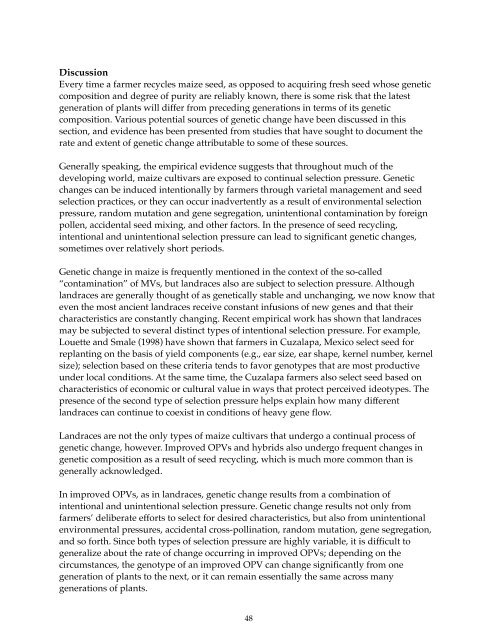A Review of the Evidence - Search CIMMYT repository
A Review of the Evidence - Search CIMMYT repository
A Review of the Evidence - Search CIMMYT repository
Create successful ePaper yourself
Turn your PDF publications into a flip-book with our unique Google optimized e-Paper software.
DiscussionEvery time a farmer recycles maize seed, as opposed to acquiring fresh seed whose geneticcomposition and degree <strong>of</strong> purity are reliably known, <strong>the</strong>re is some risk that <strong>the</strong> latestgeneration <strong>of</strong> plants will differ from preceding generations in terms <strong>of</strong> its geneticcomposition. Various potential sources <strong>of</strong> genetic change have been discussed in thissection, and evidence has been presented from studies that have sought to document <strong>the</strong>rate and extent <strong>of</strong> genetic change attributable to some <strong>of</strong> <strong>the</strong>se sources.Generally speaking, <strong>the</strong> empirical evidence suggests that throughout much <strong>of</strong> <strong>the</strong>developing world, maize cultivars are exposed to continual selection pressure. Geneticchanges can be induced intentionally by farmers through varietal management and seedselection practices, or <strong>the</strong>y can occur inadvertently as a result <strong>of</strong> environmental selectionpressure, random mutation and gene segregation, unintentional contamination by foreignpollen, accidental seed mixing, and o<strong>the</strong>r factors. In <strong>the</strong> presence <strong>of</strong> seed recycling,intentional and unintentional selection pressure can lead to significant genetic changes,sometimes over relatively short periods.Genetic change in maize is frequently mentioned in <strong>the</strong> context <strong>of</strong> <strong>the</strong> so-called“contamination” <strong>of</strong> MVs, but landraces also are subject to selection pressure. Althoughlandraces are generally thought <strong>of</strong> as genetically stable and unchanging, we now know thateven <strong>the</strong> most ancient landraces receive constant infusions <strong>of</strong> new genes and that <strong>the</strong>ircharacteristics are constantly changing. Recent empirical work has shown that landracesmay be subjected to several distinct types <strong>of</strong> intentional selection pressure. For example,Louette and Smale (1998) have shown that farmers in Cuzalapa, Mexico select seed forreplanting on <strong>the</strong> basis <strong>of</strong> yield components (e.g., ear size, ear shape, kernel number, kernelsize); selection based on <strong>the</strong>se criteria tends to favor genotypes that are most productiveunder local conditions. At <strong>the</strong> same time, <strong>the</strong> Cuzalapa farmers also select seed based oncharacteristics <strong>of</strong> economic or cultural value in ways that protect perceived ideotypes. Thepresence <strong>of</strong> <strong>the</strong> second type <strong>of</strong> selection pressure helps explain how many differentlandraces can continue to coexist in conditions <strong>of</strong> heavy gene flow.Landraces are not <strong>the</strong> only types <strong>of</strong> maize cultivars that undergo a continual process <strong>of</strong>genetic change, however. Improved OPVs and hybrids also undergo frequent changes ingenetic composition as a result <strong>of</strong> seed recycling, which is much more common than isgenerally acknowledged.In improved OPVs, as in landraces, genetic change results from a combination <strong>of</strong>intentional and unintentional selection pressure. Genetic change results not only fromfarmers’ deliberate efforts to select for desired characteristics, but also from unintentionalenvironmental pressures, accidental cross-pollination, random mutation, gene segregation,and so forth. Since both types <strong>of</strong> selection pressure are highly variable, it is difficult togeneralize about <strong>the</strong> rate <strong>of</strong> change occurring in improved OPVs; depending on <strong>the</strong>circumstances, <strong>the</strong> genotype <strong>of</strong> an improved OPV can change significantly from onegeneration <strong>of</strong> plants to <strong>the</strong> next, or it can remain essentially <strong>the</strong> same across manygenerations <strong>of</strong> plants.48
















